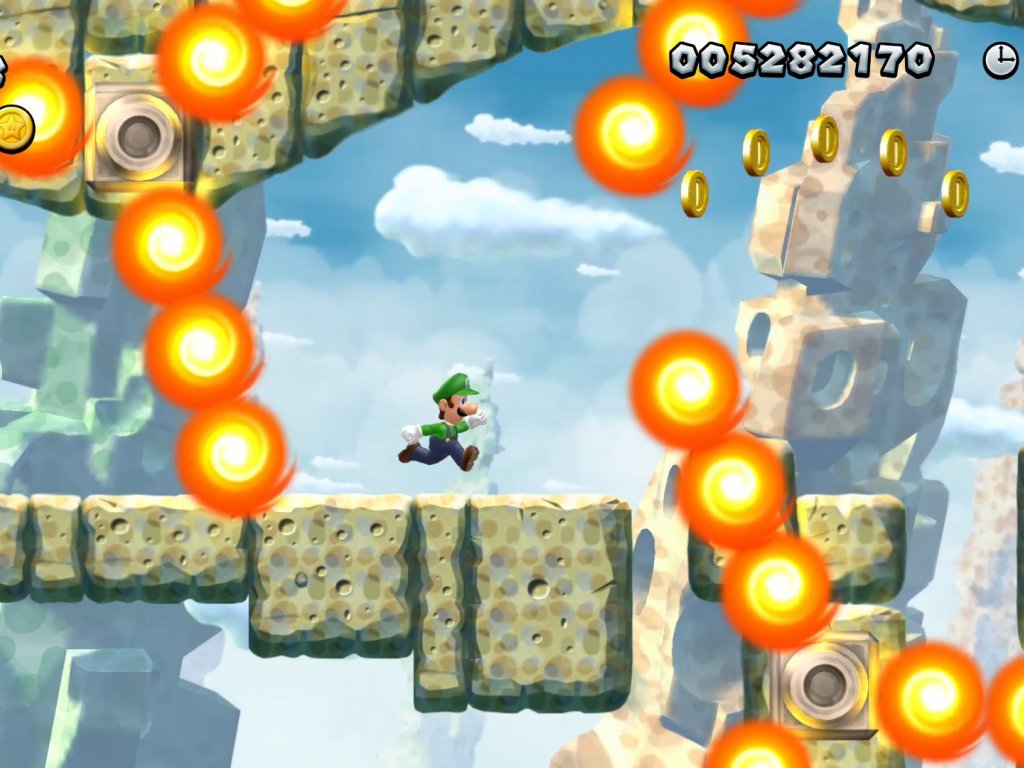Super Mario 35: 2D vs 3D

In the last episode we told you about how Koizumi, with Super Mario Galaxy, had hoped to reach the exceptional sales of the luckiest two-dimensional chapters: this is because, despite having influenced the industry like perhaps no other game, Super Mario 64 had gone very far from those results. Super Mario Galaxy turned out to be an exceptional game, but in terms of sales - and only in that field - it was outclassed by New Super Mario Bros., the first two-dimensional Super Mario - excluding Yoshi's Island - released in fifteen years. The idea, in short, proved to be valid: to create a polygonal world, with the interaction and jumps imported (in part) from the three-dimensional current of the series, merging them with the classic soul of the saga.
This is a fundamental concept to understand the essence of New Super Mario Bros.: Nintendo did not try to overturn the composition of the chapters of the past, but simply tried to re-propose them by adapting them to the technology of 2006 (taking inspiration, in particular, to the essentiality of the progenitor). The episode for DS, the first of the New Super Mario Bros., shattered every sales record of every three-dimensional title: at the end of the race, it would have exceeded thirty million units.
Galaxy 2 vs New Mario Wii
New Super Mario Bros. Wii, at the end of 2009, marked the great return (2D) of the plumber on the home console: expanding the forcibly reduced proportions of the episode DS, implementing cooperative multiplayer after the experiments of the past decades. Just like his little brother on DS, he achieved a resounding success: New Super Mario Bros. Wii sold over thirty million units and proved to be a game successful enough to call into question the forced exile of two-dimensional platformers. Donkey Kong, Kirby, Yoshi, Rayman and Wario would soon be back following his triumphal trail.Super Mario Galaxy 2, predictably and not undeservedly, achieved much more critical success than its two-dimensional cousin. And he did everything he could, without denying his soul, to become even more accessible than his predecessor: just think that, bundled with the game, a DVD was sold that explained how to perform the basic moves of the adventure. A solution completely different from Nintendo's design philosophy, indicative of how much the three-dimensional team felt the pressure of the other team's success. Super Mario Galaxy 2 was, and still remains, an extraordinary game: but in Tokyo they were not in the least interested in giving up, in accepting that the three-dimensional saga could coexist in a different dimension from the other, more prestigious but less widespread. They would continue to attack and experiment. The exact opposite of the current EPD 10, which was commissioned by Iwata to produce two more New Super Mario Bros., changing as little as possible: one for 3DS, the other for Wii U.
New Super Mario Bros. VS Super Mario 3D
Koizumi's team, in the people of Hayashida and Motokura, decided to sail towards those lands that Miyamoto himself, about twenty years earlier, had decided to avoid: he would have created a three-dimensional version of Super Mario Bros., setting aside the exploratory concepts of Super Mario 64. Super Mario 3D Land (2011) and Super Mario 3D World shortly after (including cooperative multiplayer), brought the series back to more linear terrain, leading back to the core of the experience the platformer, overcoming obstacles and platforms. To mark the end of the journey, objectively and symbolically, the flag of Super Mario Bros returned. These titles could hardly have been better realized: both turned out to be full of content and winning ideas. It is undeniable, however, that they have not been able to donate that adventurous inspiration of Super Mario 64 and Super Mario Galaxy; they didn't even get a higher success than theirs, however they managed to equal - 3D Land slightly below, 3D World slightly above - the sales of the contemporary two-dimensional Super Marioos.This connection had an unexpected effect: it was not the three-dimensional Super Maris that went up, but the two-dimensional ones that fell. Probably the internal studies were now convinced that the "hydraulic" and "two dimensions" factors would have sold out of proportion regardless of the effort, but it was not so; New Super Mario Bros. 2 and New Super Mario Bros. U have failed to deliver as many innovations as other games in the series. In particular, the first, for 3DS, presented a decidedly indecorous lack of inspiration for the saga's royal past. New Super Mario Bros. U is perhaps the most beautiful episode of these spin-offs (if they want to call them that), but it paid for the lack of ambition: it recycled, while improving it, an engine born on the Nintendo DS. It goes without saying how much more daring on Wii U could be. Both came out in 2012, on two different platforms, developed by the same team: a modus operandi that would never be repeated. The poor success of these games (compared to their predecessors, and to the imaginable expectations) has meant that, since 2012, a new two-dimensional Super Mario has not been seen (excluding DLC). Things could change soon, we hope so strongly: the fact is that, for exactly eight years, a Super Mario 2D has not been released.
Waiting for the desirable third youth of the two-dimensional series, after Super Mario 3D World it became clear that it was better to make these two branches coexist, rather than overlap them. It was time to bring Super Mario back to free jumping, large stages and to explore: it was time for a transfiguring Odyssey. We will talk about it next week, in the last episode of this special.